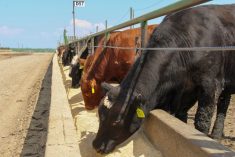CNS Canada — Quality downgrades caused by poor harvest weather has pushed a lot of wheat into feed markets, but there are few takers at this point.
Eldon Dueck, grain merchant at Linear Grain in Carman, Man., said farmer offerings in his region remain slow, but he’s heard that a lot of feed wheat and barley might be flowing into the feedlot dense areas of Alberta.
“It is a bit different (in Manitoba),” he said.
“Corn seems to be pricing in better than barley and feed wheat.”
Read Also

U.S. grains: Soy futures post biggest monthly gain in nearly five years on China trade optimism
U.S. soybean futures climbed to a 15-month high and posted their biggest monthly gain in nearly five years on Friday following a rally fueled by the prospect of revived exports to China.
Dueck said corn prices to farmers were currently about C$4.75 to C$5 per bushel.
He said Manitoba has good supplies of feed grains, but feedlots haven’t entered the market in any big way.
“I think they’ve got a good part of their stock contracted already, but there’s still some openings now that the feed barley is coming onto the market,” he said.
Prices for feed barley in his region run near C$225 per tonne, which is still fairly high for the area. Feed wheat is fetching about C$240 to C$250 per tonne, he said.
In feedlot alley of southern Alberta, Allen Pirness of Marketplace Commodities in Lethbridge, said feedlots have not been quick with new purchases despite the added feed grains, especially feed wheat, coming into the market. Most feedlots have enough.
Heavy export demand for feed barley earlier this year prompted many feedlots to hedge their positions with other supplies.
“That kind of motivated the feedlots to get a pretty decent corn position for the fall and winter here, so they’re pretty covered. There isn’t a lot of extra demand.”
Cattle placements are arriving in feedlots so that should increase feed use, he added.
Wet, cold weather for most of September prevented many farmers from harvesting their crops and that caused downgrades.
But the weather situation recently turned around and many farmers in central Alberta managed to get their crops off dry during the past two weeks. However, Pirness acknowledged there could be some pockets of higher moisture areas remaining.
“Even the stuff that was flattened into the ground, guys were taking it off dry.”
That’s good news, he added, because there are no takers for wet grain, which has to be worked into feeding rations immediately.
Prices in his area are falling, normal for this time of year, with feed barley at C$230 to $235 per tonne, for November delivery.
The feed wheat situation has become more volatile, Pirness said.
“That’s really flipped here in the last few weeks, where feed wheat was trading at a premium to barley and corn, now it’s trading at a discount.”
Feed wheat is presently selling at about C$230 per tonne in his area, he said.
“But because of the high usage of corn right now, there isn’t a lot demand for feed wheat in the feedlots.”












